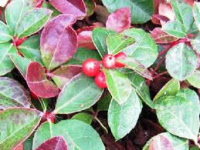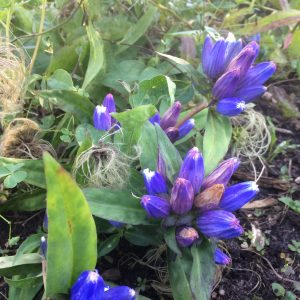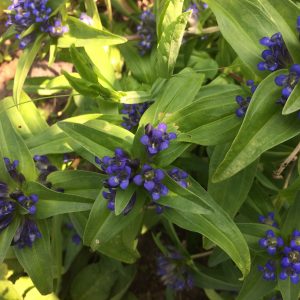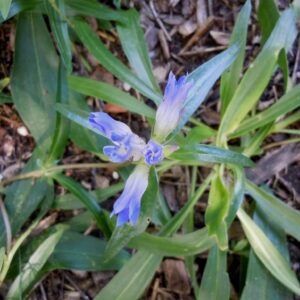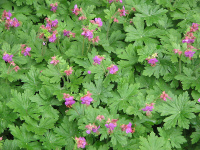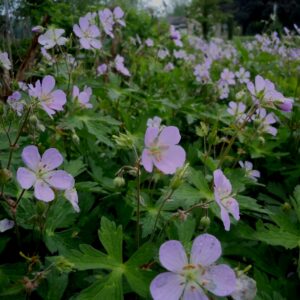Shop
Showing 321–328 of 788 results
-
Gaultheria procumbens Wintergreen, Checkerberry, Teaberry Z 3-8
“Gaultheria procumbens is in absolute perfection and beautiful – first as regards its bell-shaped blossoms, and afterwards its berries…” The Garden January 1876.
OUT OF STOCK
“Gaultheria procumbens is in absolute perfection and beautiful – first as regards its bell-shaped blossoms, and afterwards its berries…” The Garden , January 1876.
Size: 4” x 2’, spreading slowly - will make dense groundcover in time.
Care: part shade in moist to moist well-drained, acidic soil
Native: Eastern North America – Canada to Georgia west to Wisconsin
Awards: England’s Royal Horticultural Society Award of Merit.Ojibwa made tea from the leaves; the tea “makes them feel good.” Oneida used this for women having a painful menstrual cycle. For the Algonquin Wintergreen cured the common cold, headaches, grippe and stomachaches. Cherokee cured swollen gums and colds. Berries described as a grape in 1717. Named by Swedish botanist Peter Kalm after Dr. Gaulthier, with whom he botanized in Canada in 1749. Sold in America’s 1st plant catalog, Bartram’s Broadside, 1783. During the American Revolution when tea became unavailable, colonists used the plant to make tea. The tea reputedly relieved pain from headaches, muscle pains and colds. The leaves contain oil effective against pain – methyl salicylate. Pressed specimen in Emily Dickinson’s herbarium.
-
Gaura lindheimeri syn. Oenothera lindheimeri White gaura, Beeblossom Z 5-9
Multitudes of small white/pink. 4-petaled blossoms on wiry stems from May to October. Cut back by half in July to increase blossoms, as though the hoards are not enough.
ARCHIVED
Note: This is a plant not currently for sale. This is an archive page preserved for informational use.
Multitudes of small white/pink. 4-petaled blossoms on wiry stems from May to October. Cut back by half in July to increase blossoms, as though the hoards are not enough.
Size: 36” x 36”
Care: Full sun in well-drained to moist well-drained acidic soil
Native: Texas and Louisiana
Wildlife Value: deer & rabbit resistant. Source of pollen for bees, butterflies and hummingbirds
Awards: Royal Horticultural Society Award of Merit.Gaura is from the Greek gauros meaning superb. Collected in 1851 by German plant hunter Ferdinand Lindheimer (1801-1879) in the Texas Hill Country. Lindheimer considered the Father of Texas botany. L.H. Bailey (1913) wrote: “The best kind is Gaura lindheimeri which has white flowers of singular appearance, with rosy calyx tubes.”
-
Gentiana andrewsii Bottle gentian Z 4-9
Blue bottle-like or oval balloon blooms in late summer
ARCHIVED
Note: This is a plant not currently for sale. This is an archive page preserved for informational use.
Blue bottle-like or oval balloon blooms in late summer
Size: 12-24” x 6”
Care: full sun to part shade in humusy, moist to moist well drained, acidic soil
Native: Eastern North America, incl. WisconsinGentian named after King Gentius of Illyria in the Adriatic. He discovered medicinal uses for gentians around 180 B.C. Iroquois used Bottle gentian to ease pain from headaches and muscle aches, to cure lonesomeness and craziness. Hanging dried root around the house warded of witches. Meskwaki cured snake bites and “caked breast” with the plant. For the Lakota Sioux roots flavored beverages and prevented snake bites when rubbed on skin.
-
Gentiana cruciata Cross-leaf gentian Z 4-9
True-blue clusters of short trumpet flowers grow from leaf axils of upper stems, from August through September. Lance-shaped, leathery leaves crowd below and cross one another as its name describes.
True-blue clusters of short trumpet flowers grow from leaf axils of upper stems, from August through September. Lance-shaped, leathery leaves crowd below and cross one another as its name describes.
Size: 8-16” x 12-16”
Care: sun to part shade in moist or moist well-drained soil.
Native: much of Europe and East Asia
Wildlife Value: Attracts hummingbirds, butterflies, and other insects. Rabbit resistant.In mid-1700’s it was said to grow “. . .in Pannoniae, (province of the Roman Empire bounded on the north and east by the Danube) and Apenninorum, (probably about the Apennines Mountain range of Italy) and Helvetia.” (Switzerland). Linnaeus, Species Plantarum 1: 231. 1753. (1 May 1753)
Known more than 600 years ago, possibly before. Leonard Fuchs, German doctor and botanist, (1501-1566) named and described it. Renamed to its current name by botanist Caspari Bauhin (1560-1625) in Pinax Theatricum. -
Gentiana dahurica Siberian Gentian da wu li qin jiao in China Z 4-7
Clusters of dark blue tubes with white throats extend from leaf axils, blooming in mid to late summer.
Clusters of dark blue tubes with white throats extend from leaf axils, blooming in mid to late summer.
Size: 6-12” x 12”
Care: sun to part shade in moist well-drained soil
Native: China & Mongolia, Russia.
Wildlife Value: Attracts hummingbirds, bees, and butterfliesGentian named after King Gentius of Illyria in the Adriatic. He discovered medicinal uses for gentians around 180 B.C. This species described in writing in 1812.
-
Gentiana gracilipes Kansu gentian, Grass-leaved gentian Z 4-8
Lax stems sprawl on the ground while trumpet-shaped blue flowers, with darker spots inside, grow from leaf axils along stems and stem tips, blooming from July to September.
OUT OF STOCK
Lax stems sprawl on the ground while trumpet-shaped blue flowers, with darker spots inside, grow from leaf axils along stems and stem tips, blooming from July to September.
Size: 8" x 12”
Care: Sun to part shade in moist well-drained soil
Native: Mongolia, and China.
Wildlife Value: Attracts hummingbirds, bees, and butterfliesFirst published in Fl. Carniol., ed. 2, 1: 182 (1771)
-
Geranium macrorrhizum Bigroot Geranium Z 4-8
Five raspberry-purple open petals showcase its tall, purple stamens beckoning come hither to bees. Blooms in early summer. Fragrant foliage smells like pine trees at Christmas. Good groundcover in dry shade
OUT OF STOCK
Five raspberry-purple open petals showcase its tall, purple stamens beckoning come hither to bees. Blooms in early summer. Fragrant foliage smells like pine trees at Christmas. Good groundcover in dry shade
Size: 20" x 24"
Care: part shade in moist well-drained to well-drained soil
Native: Southern Europe
Awards: Elisabeth Carey Miller Botanical Garden Great Plant Pick.Geranium is Greek meaning “crane” referring to the shape of its seed resembling the bill of a crane. Cultivated in England by 1600.
-
Geranium maculatum American Cranesbill, Wild geranium, Spotted geranium Z 3-8
Clusters of two to five pink infused with lavender, flowers of five, paddle-shaped petals bloom in late spring to early summer.
Clusters of two to five pink infused with lavender, flowers of five, paddle-shaped petals bloom in late spring to early summer.
Size: 24" x 18"
Care: Full sun to part shade in moist to moist well-drained soil
Native: East North America, Wisconsin native.
Wildlife Value: primarily visited by several kinds of bees.Native Americans taught colonists to use the plant to cure diarrhea, dysentery, and hemorrhaging. Also used on sores, open wounds, canker sores and sore feet. The Choctaw prescribed it for venereal disease. Sent to Europe in 1732. Jefferson asked John Bartram to obtain seeds, 1786. Collected by French plant hunter André Michaux (1746-1802). Pressed specimen in Emily Dickinson’s herbarium.

